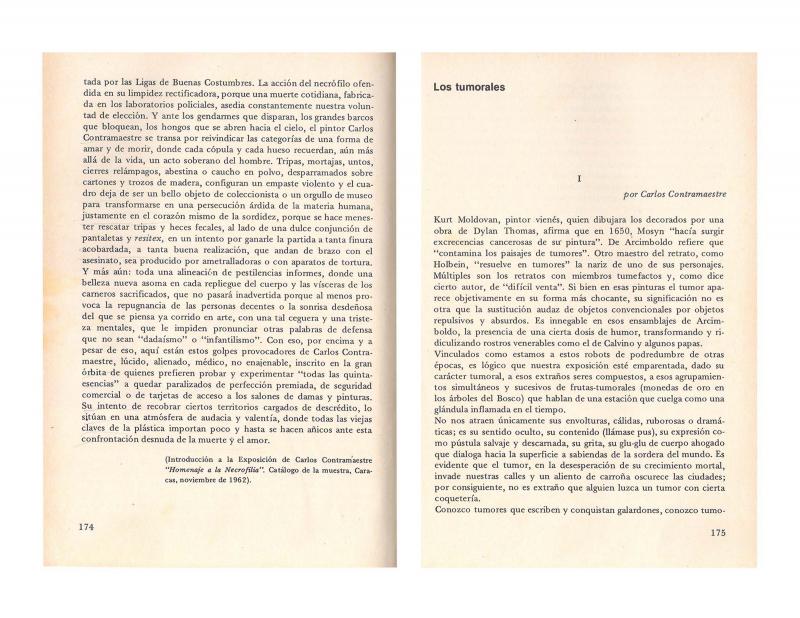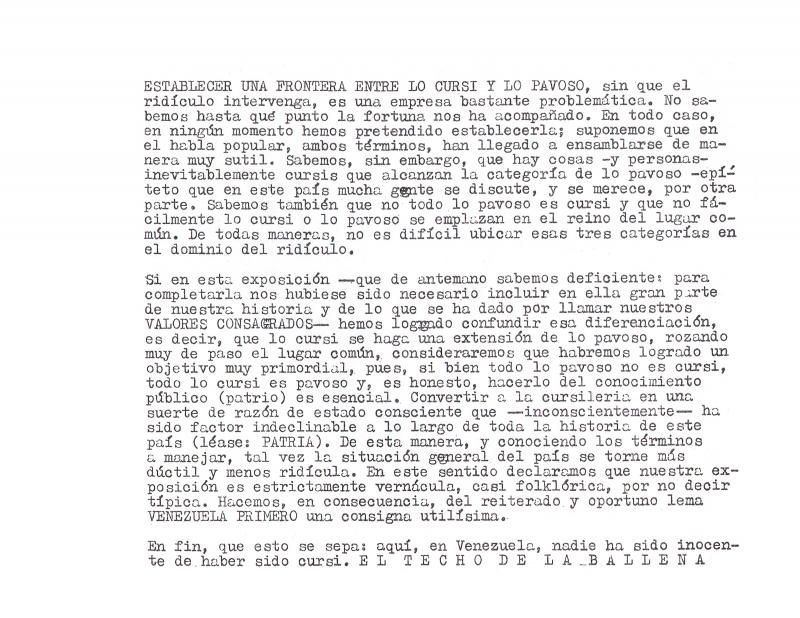In this article, the poet, critic, and draftsman Juan Calzadilla (b. 1931) speaks out on behalf of the Venezuelan painter Carlos Contramaestre and his work; both men were members of El Techo de la Ballena group (Caracas, 1961–68), which at the time, was on its last legs. Contramaestre produced two of the most controversial solo exhibitions in the history of the group: Homenaje a la Necrofilia (only in Caracas, 1962) and Tumorales (Caracas, 1963–Maracaibo, 1964). Calzadilla’s views therefore reflect a retrospective assessment of the work the painter produced while the group was active. The article refers to the main features of his work: black humor and exacerbated provocation and imagination, all of which were attacked by critics and detractors of Contramaestre’s work. Calzadilla finds that the artist’s black, corrosive humor helps to demythologize the serious, solemn subjects he seeks to profane. It also acts as a sort of security veil to protect against the rawness of the content. Calzadilla detects, in the provocation and scandal that Contramaestre pursues, an attempt to expose the human drama to the light of day. He realizes that behind Contramaestre’s highly active imagination (which he describes as Surrealist), there is an overexposure of reality.
El Techo de la Ballena was a group of visual artists and writers of the Venezuelan avant-garde who (from 1961 until 1968) combined a range of different disciplines—visual art, poetry, photography, film, and action art, among others—to create a revolutionary form of art that, in their opinion, challenged and contradicted every traditional sociocultural value during the decade of greatest political violence that ever transpired in Venezuela. The group saw themselves as the artistic expression of that chaotic period, and viewed guerrilla warfare, intellectual leftist ideas, repression, and cities devastated by the forced and accelerated developmental model of the country’s nascent democracy during the presidency of Rómulo Betancourt (1959–64) as their frame of reference. The visual artists in the group embraced Informalism as their aesthetic, to which they added a potent shot of aggressiveness to counter the values of geometric abstraction, traditional landscape painting, and even social realism, and adopted a strategy that was subversive, provocative, irrational, and surrealistic. The group produced numerous publications—including the three issues of the magazine Rayado sobre el Techo—and exhibitions. Members of the group included the Venezuelans Carlos Contramaestre, Juan Calzadilla, Caupolicán Ovalles, Edmundo Aray, Francisco Pérez Perdomo, Salvador Garmendia, Adriano González León, Fernando Irazábal, Daniel González, Gabriel Morera, Gonzalo Castellanos, and Perán Erminy, as well as artists from other countries who were living in Venezuela at the time, such as the Chilean Dámaso Ogaz, and the Spaniards J. M. Cruxent, Ángel Luque, and Antonio Moya.
[For more articles written by members of El Techo de la Ballena, see in the ICAA digital archive by Adriano González León “Homenaje a la necrofilia” (doc. no. 1097543), his essay about love, death, and necrophilia that introduced Carlos Contramaestre’s work at the Homenaje a la Necrofilia exhibition in 1962 at the Galería El Techo de la Ballena, Caracas; by Juan Calzadilla and Carlos Contramaestre “Los tumorales I y II” (doc. no. 1097559), in which they present the exhibition Los Tumorales, by Contramaestre in 1963, at the Galería El Techo de la Ballena, Caracas; also by Adriano González León “Tercer manifiesto: ¿Por qué la ballena?” (doc. no. 1097576); and by Francisco Pérez Perdomo (untitled) [“Hay ciertos rostros de la ciudad...”] (doc. no. 1060288). See also, by El Techo de la Ballena (untitled) [“Establecer una frontera entre lo cursi y lo pavoso...”] (doc. no. 1059586); “Para la restitución del magma” (doc. no. 1060710); “Las ‘Instituciones de cultura’ nos roban el oxígeno, afirman” (doc. no. 1060199); Rayado sobre el techo. Cambiar la vida, transformar la sociedad (doc. no. 1060254); and “Segundo manifiesto” (doc. no. 1057677)].









